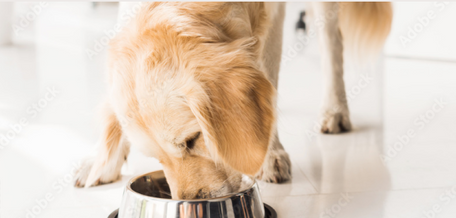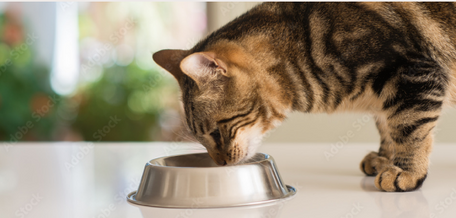
Are you considering transitioning to raw dog food and want to know what is the best approach is? We will discuss the canine’s digestive system, what are your options for transitioning, and how to transition from processed to raw dog food.
The key to transition to raw dog food is understanding how food interacts with their digestive systems.

Transitioning dogs from one type of dog food to another can result in digestive discomfort. This is true with any brand of dog food (including dry dog food). It doesn’t mean that the new dog food is better or worse than the previous one. It just means the gastrointestinal tract isn’t accustomed to the new dog food.
The canine gastrointestinal tract is really at the center of transitioning to raw dog food. When dogs’ ratio of good-to-bad bacteria in their GI tract is in a healthy balance it is called symbiosis. When it is not, it is called dysbiosis.
One of the causes of dysbiosis is improper diet. If your dog has been on a diet of kibbles (processed dog food), then their GI tract may be compromised. Then transitioning to a new food may require a more gradual transition.
Senior dogs that have spent a longer period on processed food may find a quick change in their diet challenging. This is also true for dogs with digestive sensitivities. So, we will discuss approaches that may be more appropriate for the senior and digestive sensitive dogs.
What are the options for transition to raw dog food?
We will discuss four different approaches that can be broken into two major groups: cold turkey and gradual transition approaches.

Credit: Oscar Sutton - Puppy Hero
Cold turkey is similar to quitting a bad habit. You make up your mind and you’re 100% all-in. So, you would simply quit feeding your dog process food and start feeding him raw dog food. Folks sometimes choose this method because they would rather get-r-done. This may be the best way to go for some dogs, but it is not good for every dog. This is why we have to weigh the options and base our decision on what is in the best interest of our dogs.
The gradual transition approaches are random treats, mixing process with raw dog food, or alternating between the kibbles and raw dog food.
Random treats method is using raw dog food as a treat. You would start with very small bite-size portions and not too frequent. You would then want to observe your dog for any signs of digestive discomfort. When you don’t see any signs of problems, then increase a little more frequently and maybe a little more in portion size. Gradually it would become a meal.
Another approach is to mix kibble with raw dog food. There are mixed opinions on this method. Some dogs may do fine with this approach, but we don’t recommend it. The reason is it difficult for dogs to digest rich protein from the raw food and metabolize the starchy kibbles. However, if you want to try this approach, this is how it is done. You would start by feeding 25% raw and 75% kibble for about 5 days. Then 50/50 for another 5 days. You would do 75% raw and 25% for the final 5 days. After that, make a full 100% transition to raw dog food.
The last approach is to alternate kibbles with raw feedings. This could be done in a couple of ways. You could do the first day with raw followed with the second day of kibble and repeat this for 1-2 weeks. Another approach to the alternating method is for the dog parents that feed twice a day. Feed morning meals raw or kibble and alternate the evening meal. So, if you do raw in the morning then do kibble at night.
Making the Transition to Raw Dog Food
Which approach should you use? Here is a basic guide. Use this information at your discretion.
Cold Turkey
Healthy Puppies
Healthy Young Dogs
Mixed (We don’t recommend this approach)
Healthy adult dogs
Healthy young dogs
Healthy puppies
Alternating Meals
All dogs (Including seniors and dogs with digestive sensitivities)
Random Treats
All dogs (Including seniors and dogs with digestive sensitivities)
Practical Considerations
There are a few practical things you can do to make the transition as smooth as possible. For one your dog can skip a meal before being introduced to raw food. This will serve a couple of purposes: to build up an appetite, and to clear his digestive tract to allow for maximum digestive efforts.
You also can anticipate the possibility he may need more potty breaks. Sometime even healthy dogs may need a day or two to adjust to the new food.
Dogs know how to read our emotions, so show your dog you are confident. Make him think he is getting a real treat, or simply be nonchalant about the new food. Remember the important thing is not to show you are not sure about the food. If he picks that up from you, he may borrow that bias and decide not to trust it either.
Dogs will generally prefer treats over food, so you may want to hold on the treat during the transition to raw dog food. Most of the time dogs take to raw dog food quickly, but in case your dog is the skeptical type. You could use the new dog food as a treat. Before long, he will see his new food as a treat!
We are often asked which food to start with. While this may differ in individual cases, most of the time Premium Mix is a good way to introduce dogs to a raw diet. We also recommend that dogs stay on the same meal long enough to get used to it before trying other prey or meals. The idea here is not to overwhelm their stomach with too many changes all at once.
Later you can introduce prey with bones or whole organs. Organs are richly packed with nutrients, but also can overwhelm some dog if given too early. Again, this depends on how long the dog has been eating processed food and their general sensitivities to dietary changes.
How long is the transitional period?

- Healthy puppies and young healthy dogs the transition to raw dog food could be as quick as 1-2 day
- Senior dogs and dogs with a sensitive stomach should take a more gradual approach of 1–6 weeks
Once more tip: Serve your dog’s raw food at room temperature. It will arrive frozen solid. Just store it until you're ready to defrost it. This can be done in the container by sitting it in cool water. Don’t microwave the raw food. You can store it in the refrigerator.
Changes you may see when transitioning to raw dog food.
As mentioned previously, digestion issues may occur during any dietary change. Fortunately, most of the time these are temporary. You may see diarrhea and/or vomiting. This is a natural response when the body is having trouble digesting.

There are some remedies to assist in the transition. You could use a more gradual approach or a bland diet. You could help by feeding food that is soft or ground. Another possible remedy is using our digestive supplement developed by Dr. Goldstein a veterinarian who has committed years of his life to developing natural solutions for dogs and cat’s health conditions.
Your dog may also show signs of detoxing. This could look as if he has an allergy. His eyes and nose may show some discharge. He may experience excess shedding. You may see what looks like mucus in your dog’s stool. These are signs of detoxing. This might last for 2 weeks or so.
You may also observe some behavior changes. Your dog may be requiring less water. This is because there is a lot more moisture in raw dog food than in dry kibbles. Also, kibble manufactures put salt in the kibbles causing your dog to drink more water.
After the initial transitional period, your dog will show more energy, because of the higher quality of nutrients he is getting in his food. Also, he will be more satiated. And naturally, he will be a happier dog.
Other Beneficial Changes
- Raw diets are more nutritional; therefore, canines absorb more of the food. This again leaves the dog feeling more satiated. This means less stool and less odorous.
- After the initial excess shedding, the dogs’ coat comes in shinier than before.
- Some of the odorous breath is caused by digestive issues. With healthy food, there may be an improvement in your dog’s breath.
- The starchy makeup of kibbles sticks to dogs’ teeth causing dental issues. Raw feeding avoids that and chewing on bones helps clean dogs’ teeth.
Do You Still Have Questions?
You can click on the contact us below to email us your question or come join our Facebook community.
CONTACT US





















